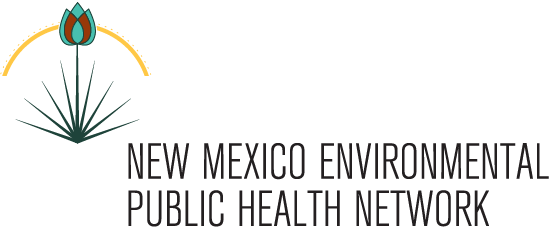May 22, 2025 –
A Grateful Note to Our Supporters
As we reflect on the 2025 legislative session, we want to extend our heartfelt thanks to each of you who stood with us in support of critical legislation for New Mexico. Whether you sent an email, made a call, attended a hearing, or helped spread awareness—your voice mattered.
Because of your efforts, we moved the needle on policies that protect rights, promote equity, and uplift our communities. Your advocacy continues to shape a stronger, more just New Mexico.
Together, we continue to move New Mexico forward with policies rooted in justice, equity, and dignity for all.
NMEPHN supported several pieces of legislation in the 2025 New Mexico legislative session.
House Bill 108, the Statewide Public Health and Climate Program, and House Bill 109, the Extreme Weather Resilience Fund. HB 108 would have created a public health and climate program in the NM Department of Health’s Environmental Health Epidemiology Bureau to help communities plan for future environmental health challenges. HB109 would have provided needed resources to communities and tribes for essential work such as creating local emergency preparedness plans, projects, activities, and climate adaptation plans related to public health. Unfortunately, neither bill made it out of the 2025 legislative session. While they passed their first committees, the budget process remains a significant hurdle. On a positive note, we made substantial progress this year with lobbying and organizational endorsements. Thank you to Rep. Kristina Ortez and Senator Liz Stefanics for their sponsorship and hard work on this legislation.
Senate Bill 48, the Community Benefit Fund, passed both chambers and was signed by the Governor. The $210 million fund, part of a broader strategy for economic growth and resilience in the state, will invest in projects that enhance community resilience, create jobs, and help residents adapt to climate challenges. The Community Benefit Fund investments include the following:
-
- $7.8 million to the Economic Development Department to diversify the state’s economy
- $15 million to the Community Energy Efficiency Development (CEED) Block Grant Fund
- $70 million to Grid Modernization Grant Fund
- $8 million to the State Supplemental Land and Water Conservation Fund for the Outdoor Equity Fund
- $40 million to the Energy, Minerals, and Natural Resources Department
- $10 million to the Department of Workforce Solutions
- $60 million to the Public Schools Facilities Authority for electric vehicle charging infrastructure and cost difference for upgrading diesel buses to electric. HB333/SB260 called for a $50 million appropriation to the New Mexico Environment Department (NMED) and would have supported assessment and clean-up of abandoned contaminated sites, like uranium mining sites. While the bill did not technically pass, an appropriation of $20 million for the work was funded in the state budget bill, HB2.
Senate Bill 21, the Pollutant Discharge Elimination System Act, protects the state’s waters by authorizing key components of a state permitting program for waters no longer protected by the federal Clean Water Act, passed both chambers and was signed by the Governor. The bill was combined with SB 22 into one program. The framework created by this bill allows the New Mexico Environment Department (NMED) to administer a Surface Water Permitting program and, therefore, have local New Mexicans in control of protecting these waters from pollution. About 95% of rivers and streams and 88% of wetlands in New Mexico are unprotected since the changes to the Clean Water Act.
New Mexico Environment Department Proposed Heat Illness and Injury Prevention Rule
The New Mexico Environment Department (NMED), Occupational Health and Safety Bureau (OHSB), has initiated a rulemaking process to promulgate a New Mexico Heat Illness and Injury Prevention rule.
According to the U.S. Occupational and Safety and Health Administration, millions of U.S. workers are exposed to heat in their workplaces. Although illness from heat exposure is preventable, thousands become sick from occupational heat exposure every year, and some cases are fatal. Physical exertion in high heat conditions is a known workplace hazard that can result in heat exhaustion and heat stroke, as well as long-term conditions such as heart and kidney damage, neurological dysfunction, and death.
The rule applies to specific industries and requires employers to establish, implement, and maintain an effective heat illness prevention plan. The proposed rule also addresses requirements for acclimatization, fluids, rest breaks, cooling areas, personnel monitoring, emergency medical care, training, and record-keeping. Visit https://www.env.nm.gov/occupational_health_safety/heat-illness-and-injury-prevention/ to read the proposed rule, make public comments, and monitor the process timeline.
See the NM Political Report article on what people are saying about the proposed rules.
https://nmpoliticalreport.com/2025/04/21/what-people-are-saying-about-nmeds-proposed-rule-to-protect-workers-from-heat/
Other News
The New Mexico Environmental Public Health Network, as part of New Mexico Voices for Children, participated in the recent Heat Summit, led by Healthy Climate New Mexico. At the Summit, leading experts on extreme heat presented critical information for health professionals to learn about how extreme heat’s health impacts are currently playing out and how we can all work toward mitigating and preventing the health effects of extreme heat. Visit https://www.healthyclimatenm.org/heatsummit2025 to view the slides and listen to the Summit.
The Early Childhood Scientific Council on Equity and the Environment has published papers and provided other essential resources on two critical topics related to children’s health – water and extreme heat. See resources on extreme heat here and resources on water and early childhood development:




